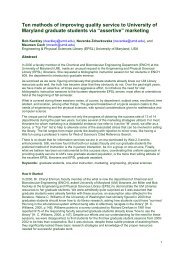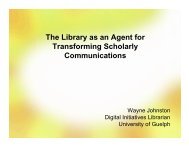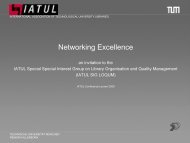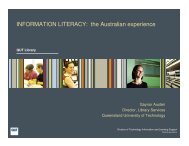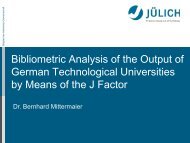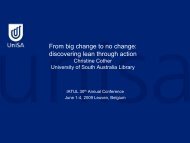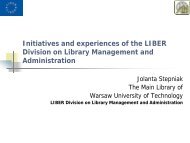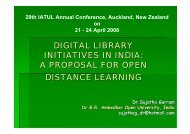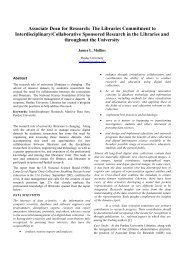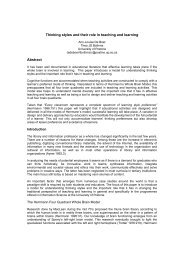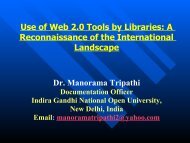Derek Whitehead - IATUL
Derek Whitehead - IATUL
Derek Whitehead - IATUL
Create successful ePaper yourself
Turn your PDF publications into a flip-book with our unique Google optimized e-Paper software.
open licences, or sharing arrangements such as the National Educational Access Licence for Schools<br />
(NEALS) (Curriculum Corporation, 2008). Legislative amendments to the Copyright Act 1968 at the<br />
end of 2006 also incorporated a new exception with significant benefits to education and libraries<br />
(Simes 2008). Universities have also begun in some cases to provide open course materials – such as<br />
University of Southern Queensland’s OpenCourseWare (Cobcroft 2008, pp.183-4)<br />
Geospatial information<br />
The Cutler report refers to geospatial information as an area which is well advanced in policy<br />
development for open access. Geosciences Australia (GA) has an Australian Government Policy on<br />
Spatial Data Access and Pricing, launched in 2001. Maps and other products of Geoscience Australia<br />
are available without charge, and under a generous licence which permits the user to<br />
“a. use, reproduce, adapt, modify, commercially exploit and communicate the Data (including by<br />
development and distribution of a Deriviative Product); and<br />
b. sublicense the Licensee's right to use, reproduce, adapt, modify, commercially exploit and<br />
communicate the Data, subject to the terms of this Licence.” (Geosciences Australia 2001)<br />
Statistics<br />
In December 2005 the Australian Bureau of Statistics (ABS), the national statistical agency, made all<br />
statistics available from the ABS website free of charge. More recently, in December 2008, ABS<br />
modified the licence involved in using its statistics, and placed all material under a Creative Commons<br />
Attribution 2.5 Australia licence. There are very few exceptions – “except the ABS logo, the<br />
Commonwealth Coat of Arms, and any material protected by a trade mark.” (ABS 2009) This means<br />
that this material may be adapted and re-used, and may be used for commercial as well as noncommercial<br />
purposes.<br />
Legal information<br />
The Australian Legal Information Institute (AUSTLII) is a joint enterprise of the Faculties of Law of<br />
University of New South Wales and the University of Technology Sydney. AUSTLII makes available<br />
public legal information – “legislation, treaties and decisions of courts and tribunals); and secondary<br />
legal materials created by public bodies for purposes of public access (law reform and royal<br />
commission reports for example) and a substantial collection of law journals.” (AUSTLII, 2009)<br />
AUSTLII is a free service and is maintained by the two institutions which created it, deriving income<br />
from grants and donations. Material on the site is reproduced with the permission of copyright owners<br />
and government entities.<br />
The Australian Broadcasting Corporation<br />
The Australian Broadcasting Corporation (ABC) is a national broadcaster, providing radio, television<br />
and internet services to Australians and overseas. The ABC has the largest audiovisual archive in<br />
Australia, and has recently established a collaborative media site, Pool. This provides material<br />
available for re-use, and has recently released material into the pool using a Creative Commons<br />
Attribution-Noncommercial licence – the first use by the ABC of a CCA licence. In practice, the licence<br />
enables others to re-mix and re-use provided that it is for a non-commercial purpose (ABC, 2009)<br />
Part 5: Conclusion<br />
It is quite clear that well before the Cutler report there was much movement in government towards a<br />
range of measures which would make copyright, at least in relation to government information, more<br />
hospitable to innovation. There is a wide range of tools now emerging to make it easier for those<br />
involved in innovation and creation to re-use and build upon the work of others. These include<br />
• New licensing models – in particular open licences, and amongst those, the Creative Commons<br />
licences. These are now international, and are used in many different contexts in government and<br />
elsewhere. At the same time, other forms of open licences are also used.<br />
• New ways of handling government information for the benefit of all are being developed. Although<br />
there has always been a model for this in the case of the United States, other countries –<br />
especially Crown Copyright countries – are moving to the view that innovation and economic<br />
advance take place when government-controlled information is made freely available to those who<br />
can exploit it.<br />
• New approaches to research are being taken, which recognise government-supported research in<br />
particular as a public asset. The movement to open access to research repositories, fostered by<br />
6



